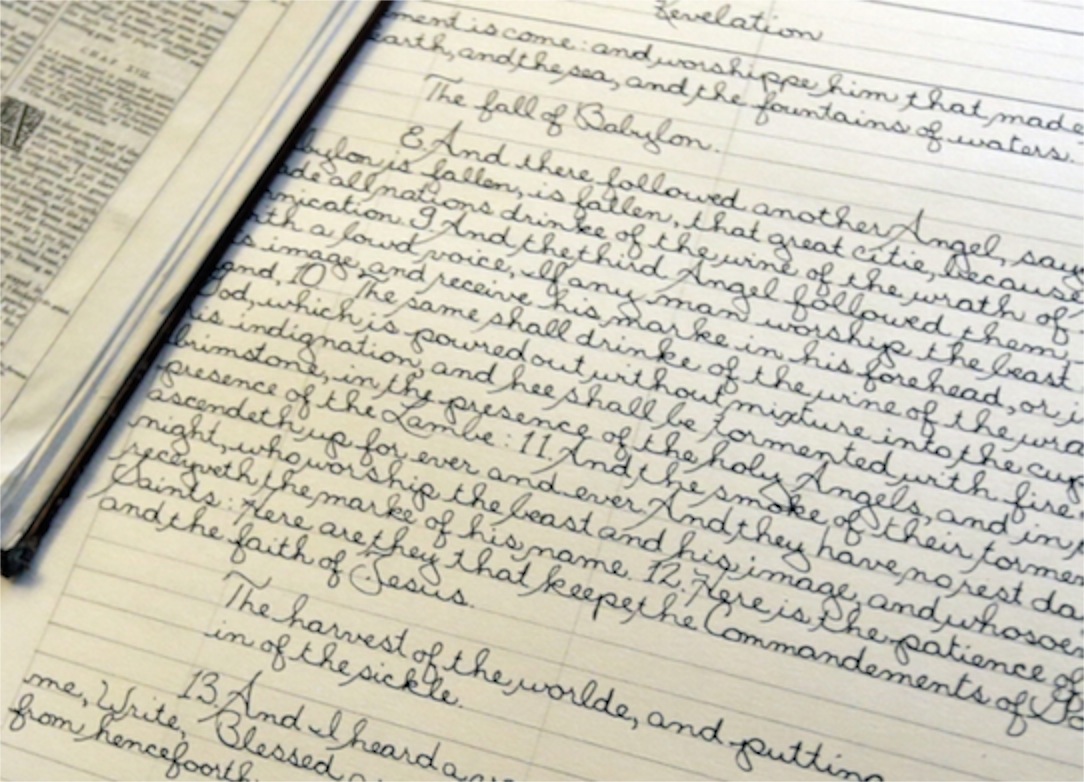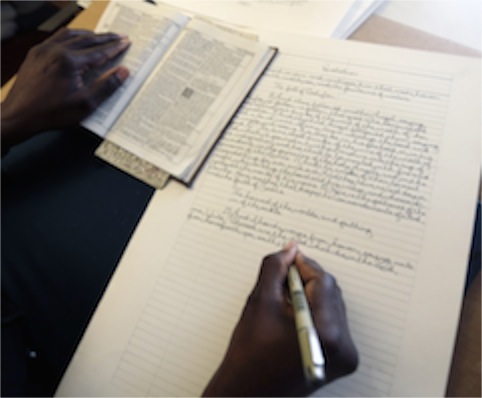Handwritten Bible
13/05/13 04:16

I have a penchant for stationary and office supply stores. Over the years, I have probably spent too many dollars on pens and pads and journals and other such things. My briefcase usually has three or four pens in it. My desk fills up with pens if I am not careful. It is a vice I come by naturally. Our mother loved pens and pencils and pads. Such items were often in our stockings at Christmas. I haven’t gone in for the expensive varieties of pens. The luxury pens by Cross and Mont Blanc sold in office supply stories are often not much more than well-designed and expensively made cases wrapped around similar interior components of less-expensive writing instruments. Like other luxury items we would probably be surprised, and perhaps horrified, to find out how expensive some individual instruments are. Put a few diamonds in the cap and the price could go through the ceiling. I’m sure that there are pens available for tens of thousands of dollars.
I have no desire for such an instrument. I have a fine pen with a single pearl on it that I received as a gift from the family of an exchange student. I’ve used it a few times, but most of the time it rests in my dresser because I am afraid of losing it. Twice over the years I have found it dried out and have had trouble finding just the right refill to bring it back. It is a bit narrow and a bit slippery for comfortable writing.
If handwriting is important, the Sakura Pigma Micron is a very nice pen. They come in several different tip widths from 0.25 to 0.45 and are available for just under $3. The pigma ink is reported to be permanent – at least it will last much longer than a single human lifetime. The pens are used by archivists, artists and others to whom permanence of writing is important. The archival quality ink works well on acid free papers. The ink will not smear or feather when dry and does not bleed through most papers.

The retired interior designer undertook the discipline to get to know the Bible better. He stated that he often doesn’t retain everything that he reads and he figured that writing the entire document would bring him a familiarity and intimacy with the Bible that he could not obtain any other way. I suspect that it worked. I suspect that at least some of the words got under his skin.
It is a monumental effort. Some days he worked as many as 18 hours on the project. His work was slowed by medical treatments and health limitations. Mr. Patterson suffers from AIDS and anemia. He uses two canes to walk and needs to steady himself with walls and furniture when he gets up.
He has no illusions about what he has done. He didn’t write in expectation of some magical cure for his illness. The effort wasn’t some attempt to atone for past mistakes or to earn his salvation. He says that handwriting is just one form of preserving a document. He openly states that the Bible is not accepting of the lifestyle he adopted for much of his life. He simply says that he undertook the task because he always wanted to know what was in the Bible.
From the samples I have seen, the man has incredible penmanship. My cursive is neither so regular nor so neat has his writing, even after 788,000 words undertaken one at a time.
For centuries monks have engaged in handwriting Bibles as a spiritual discipline – an expression of a lifetime dedicated to prayer and service. Mr. Patterson hasn’t joined an order or professed sacred vows. He simply found a meaningful pursuit in his retirement and stuck with it until it was completed. His work, however, is no less sacred than that undertaken by those wearing robes. His apartment is no less a sacred space than a cloister.
The struggle to make the Bible accessible to all people, regardless of their station in life, was long-fought and often contentious. The story of the King James Version of the Bible is itself one of intrigue, struggle and controversy. Somehow, however, it has come down through the years as a document that can be owned by individuals.
The true scripture is not the words printed by a press and bound into a volume. It is not the books stacked neatly in rows in the classrooms at the church. It is not even page after page of looping cursive words handwritten with a Pigma Micron pen on acid-free watercolor paper. The true scriptures of our people are the ideas that are written on the hearts of faithful people and played out in lives of humble service to others. Mr. Patterson’s Bible is a unique gift – a gift of faith. It will be treasured for generations by his church. And it will be easy for him to give it away.
He knows that the words and ideas on his mind and in his heart are more precious than words on paper – and those will be with him forever.